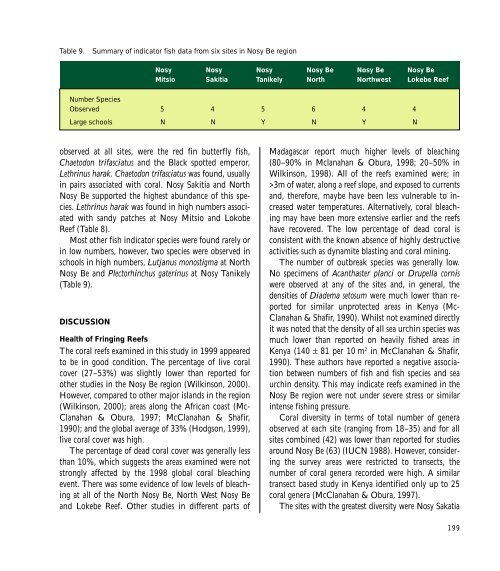You also want an ePaper? Increase the reach of your titles
YUMPU automatically turns print PDFs into web optimized ePapers that Google loves.
Table 9.<br />
Summary of indicator fish data from six sites in Nosy Be region<br />
Nosy Nosy Nosy Nosy Be Nosy Be Nosy Be<br />
Mitsio Sakitia Tanikely North Northwest Lokebe Reef<br />
Number Species<br />
Observed 5 4 5 6 4 4<br />
Large schools N N Y N Y N<br />
observed at all sites, were the red fin butterfly fish,<br />
Chaetodon trifasciatus and the Black spotted emperor,<br />
Lethrinus harak. Chaetodon trifasciatus was found, usually<br />
in pairs associated with coral. Nosy Sakitia and North<br />
Nosy Be supported the highest abundance of this species.<br />
Lethrinus harak was found in high numbers associated<br />
with sandy patches at Nosy Mitsio and Lokobe<br />
Reef (Table 8).<br />
Most other fish indicator species were found rarely or<br />
in low numbers, however, two species were observed in<br />
schools in high numbers, Lutjanus monostigma at North<br />
Nosy Be and Plectorhinchus gaterinus at Nosy Tanikely<br />
(Table 9).<br />
DISCUSSION<br />
Health of Fringing Reefs<br />
The coral reefs examined in this study in 1999 appeared<br />
to be in good condition. The percentage of live coral<br />
cover (27–53%) was slightly lower than reported for<br />
other studies in the Nosy Be region (Wilkinson, 2000).<br />
However, compared to other major islands in the region<br />
(Wilkinson, 2000); areas along the African coast (Mc-<br />
Clanahan & Obura, 1997; McClanahan & Shafir,<br />
1990); and the global average of 33% (Hodgson, 1999),<br />
live coral cover was high.<br />
The percentage of dead coral cover was generally less<br />
than 10%, which suggests the areas examined were not<br />
strongly affected by the 1998 global coral bleaching<br />
event. There was some evidence of low levels of bleaching<br />
at all of the North Nosy Be, North West Nosy Be<br />
and Lokebe Reef. Other studies in different parts of<br />
Madagascar report much higher levels of bleaching<br />
(80–90% in Mclanahan & Obura, 1998; 20–50% in<br />
Wilkinson, 1998). All of the reefs examined were; in<br />
>3m of water, along a reef slope, and exposed to currents<br />
and, therefore, maybe have been less vulnerable to increased<br />
water temperatures. Alternatively, coral bleaching<br />
may have been more extensive earlier and the reefs<br />
have recovered. The low percentage of dead coral is<br />
consistent with the known absence of highly destructive<br />
activities such as dynamite blasting and coral mining.<br />
The number of outbreak species was generally low.<br />
No specimens of Acanthaster planci or Drupella cornis<br />
were observed at any of the sites and, in general, the<br />
densities of Diadema setosum were much lower than reported<br />
for similar unprotected areas in Kenya (Mc-<br />
Clanahan & Shafir, 1990). Whilst not examined directly<br />
it was noted that the density of all sea urchin species was<br />
much lower than reported on heavily fished areas in<br />
Kenya (140 ± 81 per 10 m 2 in McClanahan & Shafir,<br />
1990). These authors have reported a negative association<br />
between numbers of fish and fish species and sea<br />
urchin density. This may indicate reefs examined in the<br />
Nosy Be region were not under severe stress or similar<br />
intense fishing pressure.<br />
Coral diversity in terms of total number of genera<br />
observed at each site (ranging from 18–35) and for all<br />
sites combined (42) was lower than reported for studies<br />
around Nosy Be (63) (IUCN 1988). However, considering<br />
the survey areas were restricted to transects, the<br />
number of coral genera recorded were high. A similar<br />
transect based study in Kenya identified only up to 25<br />
coral genera (McClanahan & Obura, 1997).<br />
The sites with the greatest diversity were Nosy Sakatia<br />
199


















